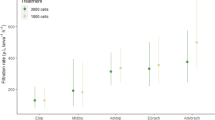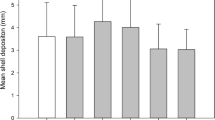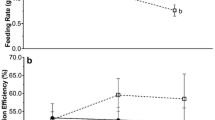Abstract
In addition to a control Crassostrea virginica was treated with 3 and 5 μg As kgp-1 for 16 wks at ambient seawater salinity and temperature to determine the potential of C. virginica as an indicator of arsenic pollution. Prior to spawning, as much as 10.3±1.5, 12.7±2.7, and 14.1±3.7 μg As gp-1 dry weight were accumulated in the total soft parts of oysters after treatment with ambient (control), 3 and 5 μg As kg-1, respectively. Immediately after spawning, an increase in tissue arsenic concentration was observed in all treatments up to week 12, after which a decrease in tissue arsenic concentrations occurred despite continuous addition of arsenic to the seawater. During the uptake period, a significant inverse relationship existed between dry weight and tissue arsenic concentration, whereas a significant direct relationship was apparent between dry weight and tissue content. Arsenic concentration in the total soft parts is not significantly related to seawater arsenic concentration over the range of concentrations used in this study. In all three treatments, arsenic uptake as concentration (μg gp-1) is not a significant linear function of time. Weight loss was significant but gradual during the first 16 wks of treatment and did not change significantly during the depuration period (wks 17–25). Tissue arsenic concentrations increased significantly in oysters from all three treatments during the depuration period. Generally, arsenic body burdens increased with increases in phytoplankton concentration and it appears that food contributes more to arsenic uptake than seawater arsenic concentrations. Since a relationship between tissue arsenic concentration and seawater arsenic concentration does not appear to exist, C. virginica would not be a good biological indicator of arsenic concentration in its environment.
Similar content being viewed by others
References
Andreae, M. O.: 1978, ‘Distribution and Speciation of Arsenic in Natural Waters and Some Marine Algae’, Deep-Sea Res. 25, 391–402.
Barszcz, C. A., Yevich, P. P., and Zaroogian, G. E.: (in press), ‘Chronic and Latent Effects of Sodium Arsenite in the American Oyster Crassostrea viriginica’, J. Environm. Pathology and Toxicology.
Bohn, A.: 1975, ‘Arsenic in Marine Organisms from West Greenland’, Mar. Pollut. Bull. 6, 87–89.
Braman, R. S. and Foreback, C. C.: 1973, ‘Methylated Forms of Arsenic in the Environment’, Science 182, 1247–1249.
Chapman, A. C.: 1926, ‘On the Presence of Compounds of Arsenic in Marine Crustaceans and Shell Fish’, Analyst 51, 548–563.
Cunningham, P. A. and Tripp, M. R.: 1973, ‘Accumulation and Depuration of Mercury in the American Oyster Crassostrea virginica’, Mar. Biol. 20, 14–19.
Cunningham, P. A. and Tripp, M. R.: 1975a, ‘Accumulation, Tissue Distribution and Elimination of p203HgCl2 and CH3 203HgCl in the Tissues of the American Oyster Crassostrea virginica’, Mar. Biol. 31, 231–234.
Cunningham, P. A. and Tripp, M. R.: 195b, ‘Factors Affecting the Accumulation and Removal of Mercury from Tissues of the American Oyster Crassostrea viriginica’, Mar. Biol. 31, 311–319.
Fondekar, S. P. and Reddy, C. V. G.: 1974, ‘Arsenic Content in the Coastal and Estuarine Waters Around Goa. Mahasagar’, Bull. Natl. Inst. Oceanogr. (india) 7, 27–32.
Gorgy, S., Rakestraw, N. W., and Fox, D. L.: 1948, ‘Arsenic in the Sea’, J. Mar. Res. 7, 22–32.
Johnson, S. L. and Pilson, M. E. Q.: 1972, ‘Arsenate in the Western North Atlantic and Adjacent Regions’, J. Mar. Res. 30, 140–149.
Kennedy, V. S.: 1976, ‘Arsenic Concentration in Some Coexisting Marine Organisms from Newfoundland and Labrador’, J. Fish. Res. Bd. Can. 33, 1388–1393.
LeBlanc, P. J. and Jackson, A. L.: 1973, ‘Arsenic in Marine Fish and Invertebrates’, Mar. Pollut. Bull. 4, 88–90.
Lunde, G.: 1972, The Absorption and Metabolism of Arsenic in Fish, Reports on Technological Research Concerning Norwegian Fish Industry, Directorate of Fisheries, Bergen, Vol. 5, No. 12.
Lunde, G.: 1972a, ‘The Analysis of Arsenic in the Lipid Phaso from Marine and Limnetic Algae’, Acta Chemica Scandinavica 26, 2642–2644.
Lunde, G.: 1973, ‘The Synthesis of Fat and Water Soluble Arseno Organic Compounds in Marine and Limnetic Algae’, Acta Chem. Scand. 27, 1586–1594.
Lunde, G.: 1976, ‘Comparison of Arseno-organic Compounds from Different Marine Organisms’, J. Sci. Food Agric. 26, 1257–1261.
MacKay, N. J., Williams, R. J., Kacprzac, J. L., Kazacos, M. N., Collins, A. J., and Auty, E. H.: 1975, ‘Heavy Metals in Cultivated Oysters (Crassostrea commercialis = Saccostrea cucullata) from the Estuaries of New South Wales’, Aust. J. Mar. Freshwat. Res. 26, 31–46.
Penrose, W. R.: 1975, ‘Biosynthesis of Organic Compounds in Brown Trout (Salmo trutta)’, J. Fish. Res. Bd. Can. 32, 2385.
Penrose, W. R., Black, R., and Hayward, M. J.: 1975, ‘Limited Arsenic Dispersion in Seawater, Sediments and Biota near a Continuous Source’, J. Fish. Res. Bd. Can. 32, 1275–1281.
Penrose, W. R., Conacher, H. B. S., Black, R., Meranger, J. C., Miles, W., Cunningham, H. M., and Squires, W. R.: 1977, ‘Implications of Inorganic/Organic Interconversion on Fluxes of Arsenic in Marine Food Webs’, Envir. Hlth. Perspectives 19, 53–59.
Unlu, M. Y. and Fowler, S. W.: 1979, ‘Factors Affecting the Flux of Arsenic Through the Mussel Mytilus galloprovincialis’, Mar. Biol. 51, 209–219.
Winter, J. E.: 1969, ‘Über den Einfluss der Nahrungskonzentration and anderer Faktoren auf Filtrierleistung und Nährungsausnutzung der Muscheln Arctica islandica and Modiolus modiolus’, Mar. Biol. 4, 87–135.
Zaroogian, G. E., Morrison, G., and Heltshe, J. F.: 1979, ‘Crassostrea viriginica as an Indicator of Lead Pollution’, Mar. Biol. 52, 189–196.
Zaroogian, G. E.: 1980, ‘Crassostrea virginica as an Indicator of Cadmium Pollution’, Mar. Biol. 58, 275–284.
Author information
Authors and Affiliations
Rights and permissions
About this article
Cite this article
Zaroogian, G.E., Hoffman, G.L. Arsenic uptake and loss in the American oyster, Crassostrea virginica . Environ Monit Assess 1, 345–358 (1982). https://doi.org/10.1007/BF00403835
Received:
Issue Date:
DOI: https://doi.org/10.1007/BF00403835




